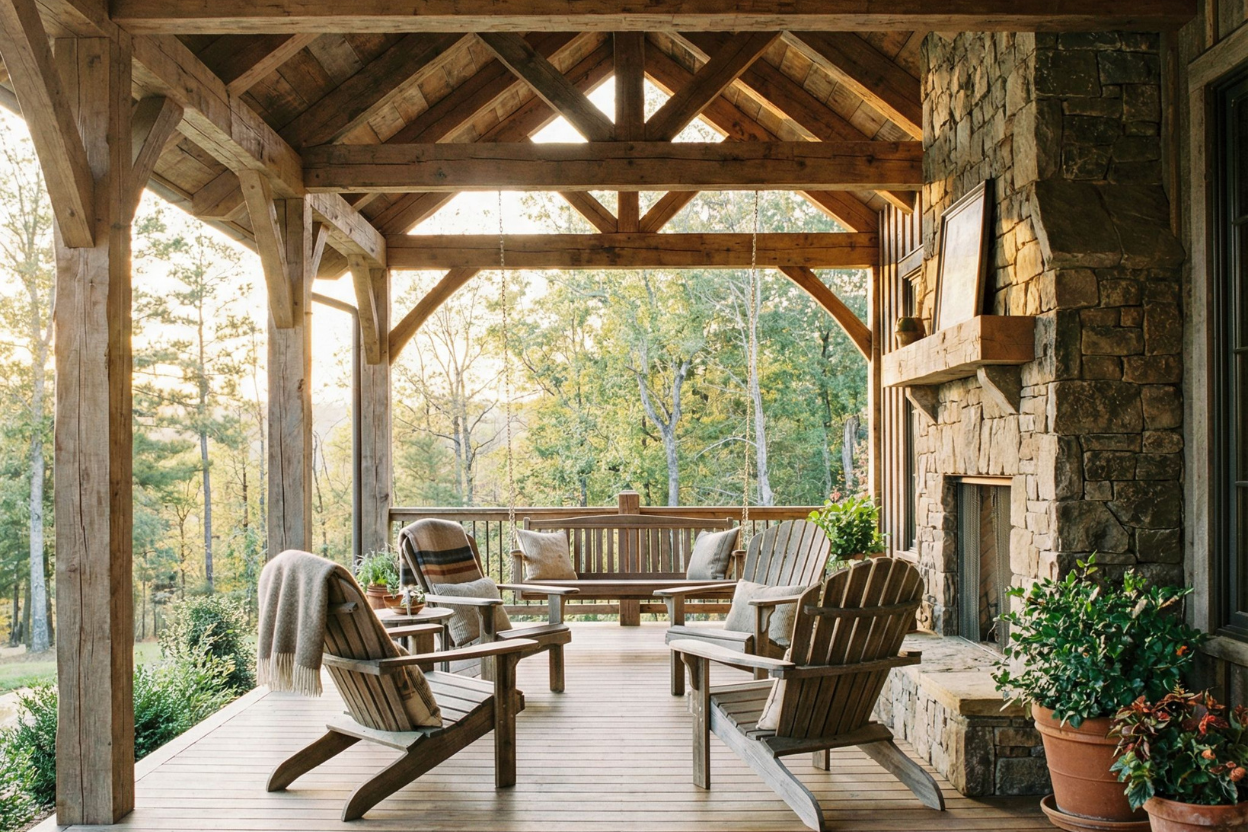
The covered front porch represents more than architectural necessity—it’s the psychological threshold between public and private life. This transitional space shapes first impressions while offering year-round sanctuary from the elements. From traditional designs to contemporary innovations, these 36 covered porch concepts demonstrate how thoughtful design creates welcoming entries that function beautifully regardless of weather conditions.
In order to come up with the very specific design ideas, we create most designs with the assistance of state-of-the-art AI interior design software.
Traditional Covered Front Porch with White Columns
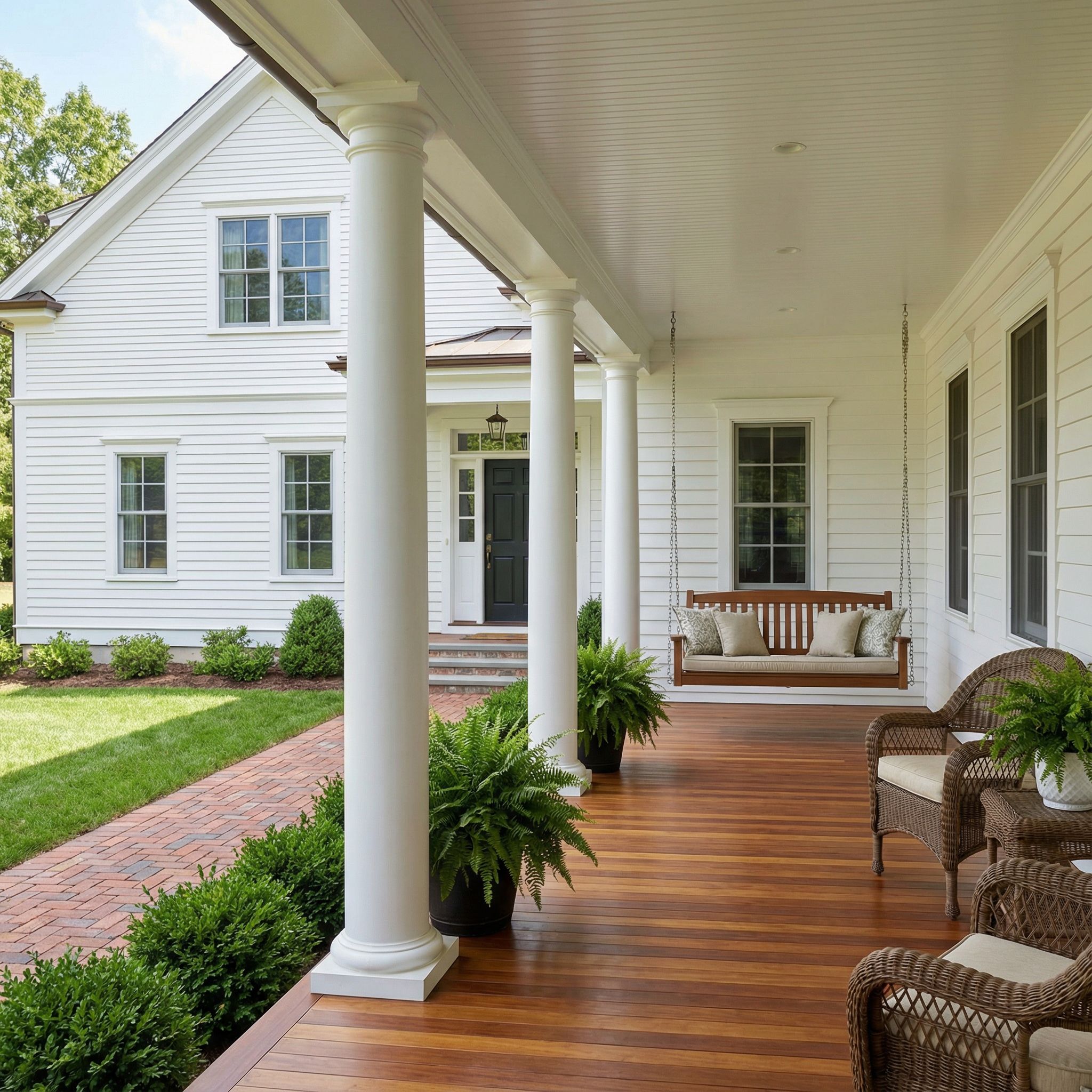
White columns evoke timeless American architecture, creating what I call “permanence elegance”—designs that feel both established and inviting. These vertical sentinels frame views while supporting substantial roof overhangs that protect against summer sun and winter precipitation. The crisp white finish reflects light beautifully, keeping spaces bright even on overcast days while requiring minimal seasonal adjustment for year-round enjoyment.
Modern Farmhouse Covered Front Porch Design

The modern farmhouse porch balances rustic charm with contemporary restraint, embodying “curated simplicity.” Featuring wide plank ceilings, mixed materials like metal roofing with wood supports, and neutral palettes, these porches work seasonally because they avoid fussy details that weather poorly. The clean aesthetic allows seasonal décor to shine without competing with permanent architectural elements.
Wraparound Covered Front Porch with Rocking Chairs

Wraparound porches offer “panoramic sanctuary,” providing protected outdoor space accessible from multiple rooms while maximizing covered square footage. The extended roofline creates microclimates—sunny morning spots, shaded afternoon corners—allowing inhabitants to follow comfortable conditions throughout seasons. Strategic rocking chair placement encourages lingering regardless of temperature, making this design psychologically restorative year-round.
Screened Covered Front Porch for Bug Protection
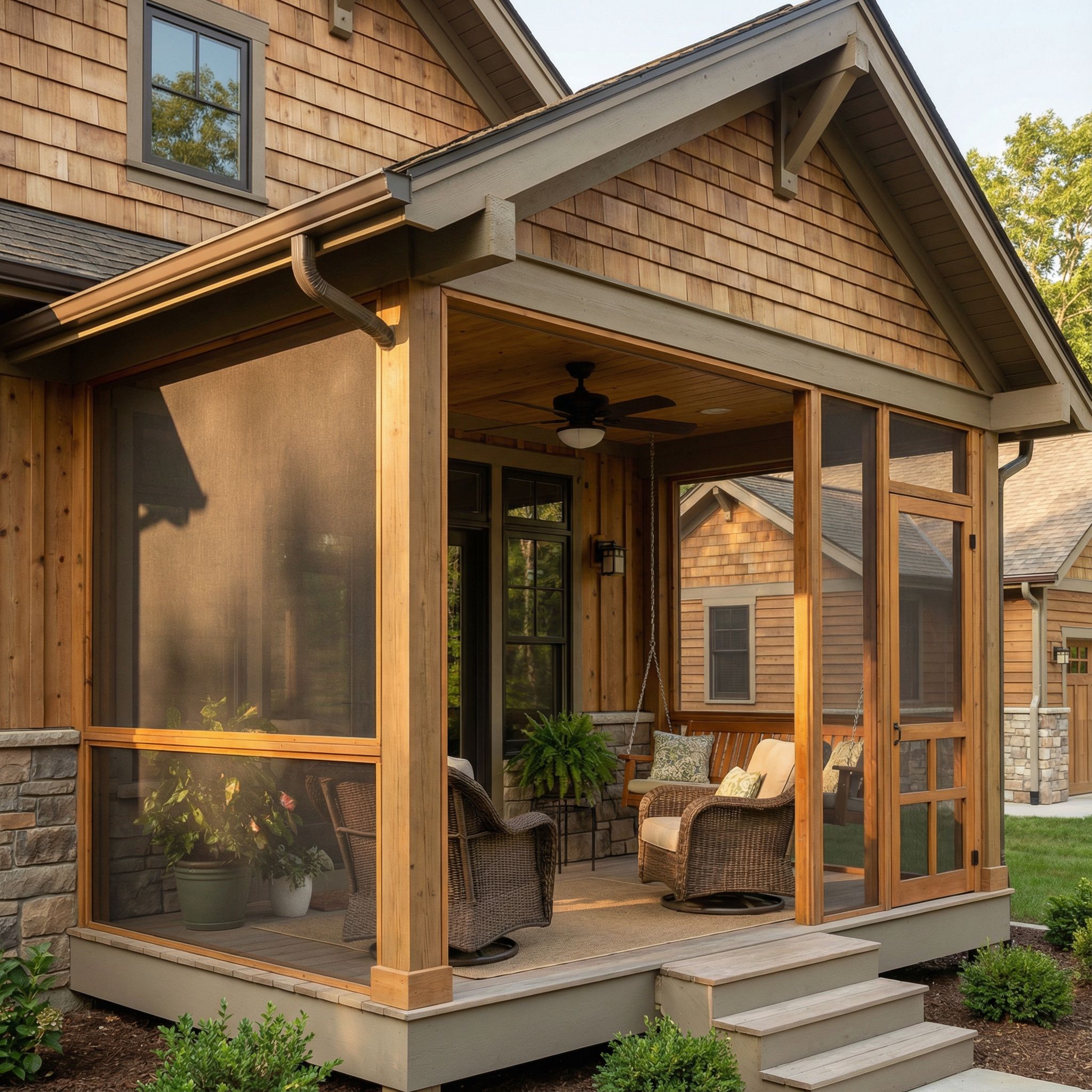
Screening transforms porches into “climate-controlled nature rooms” where fresh air circulates without insect intrusion. This design excels during humid summers while remaining functional in cooler months when screens can be supplemented with clear vinyl panels. The psychological benefit is significant—experiencing weather changes from protected comfort creates deeper seasonal connection without discomfort.
Minimalist Covered Front Porch with Clean Lines

Minimalist porches practice “architectural meditation,” stripping away ornament to emphasize form, shadow, and materiality. Simple roof planes supported by slender posts create elegant protection without visual clutter. This restraint actually enhances seasonal appreciation—unobstructed views of changing landscapes become the decoration, while clean surfaces shed snow, rain, and leaves effortlessly throughout the year.
Southern-Style Covered Front Porch with Swing
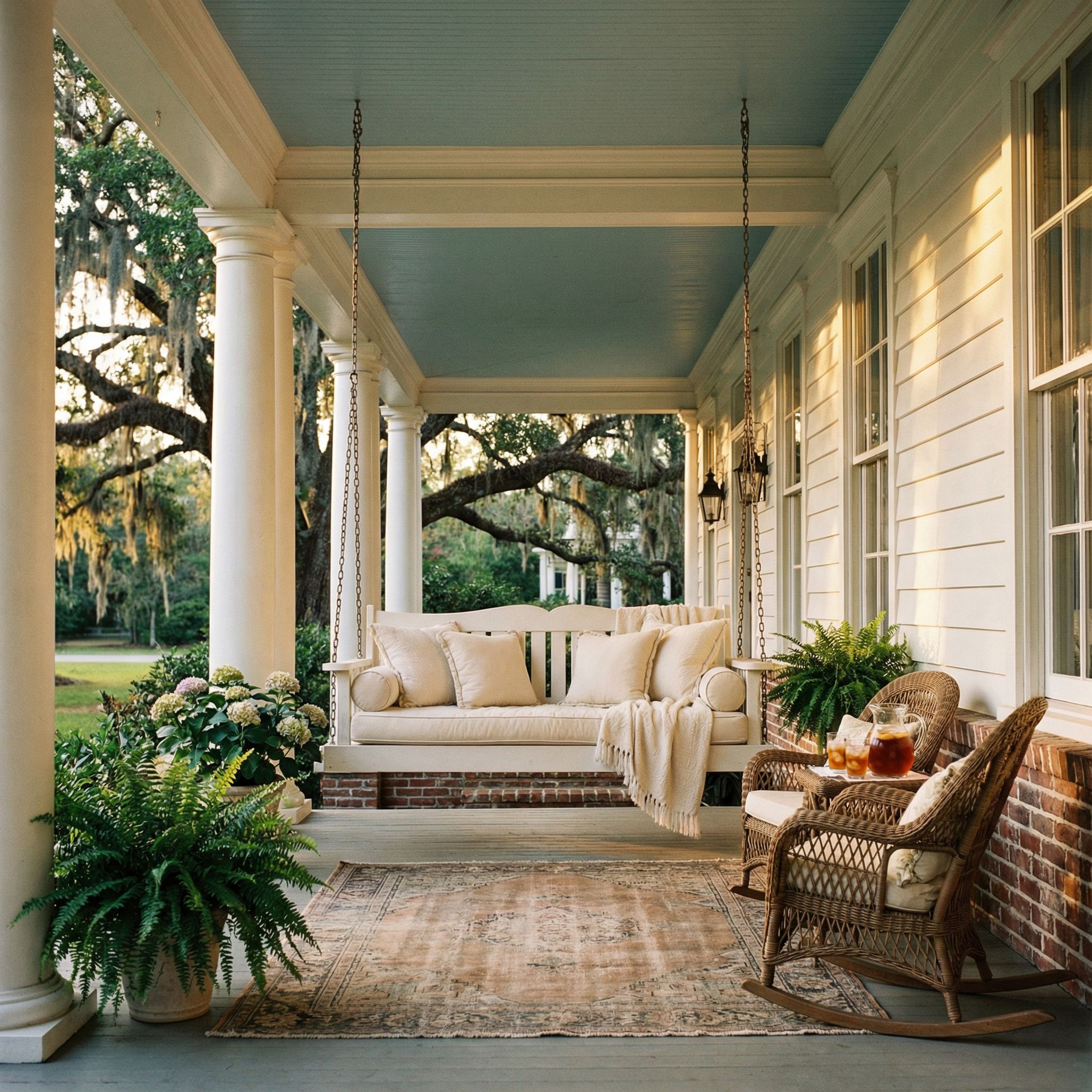
The quintessential porch swing epitomizes “motion comfort”—gentle swaying that psychologically soothes while physically cooling through air movement. Deep Southern porches with substantial overhangs create shade pockets that remain comfortable even during scorching summers. Come autumn and spring, the same protected space offers pleasant outdoor sitting during unpredictable weather, making swings four-season features.
Craftsman Covered Front Porch with Tapered Columns
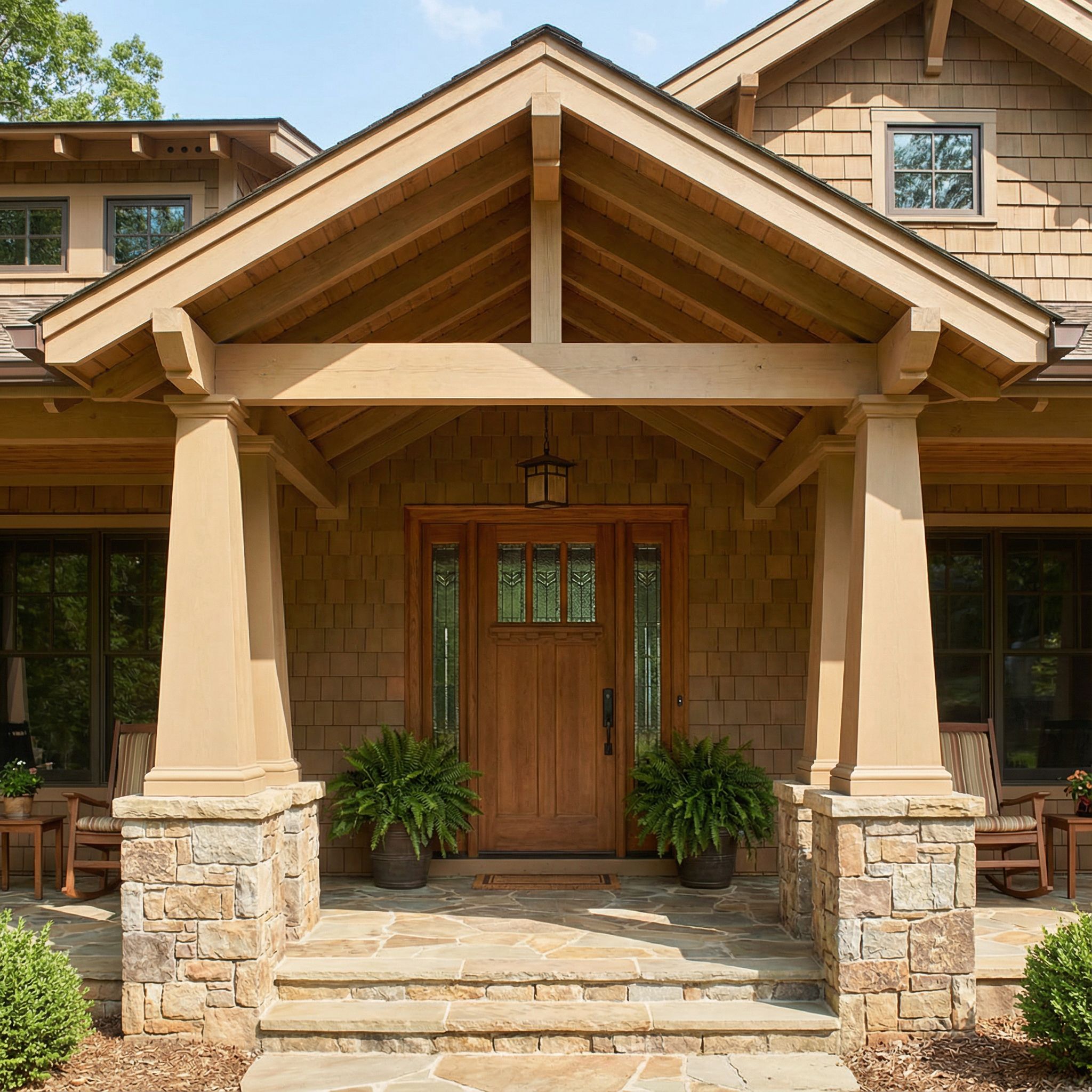
Craftsman tapered columns demonstrate “grounded strength,” widening at the base to suggest stability while maintaining visual interest through proportion. Often combined with stone or brick bases, these columns anchor porches psychologically and practically. The substantial construction withstands seasonal extremes while decorative brackets and exposed rafter tails add character without compromising the weather-shedding roof functionality.
Small Covered Front Porch with Maximum Impact
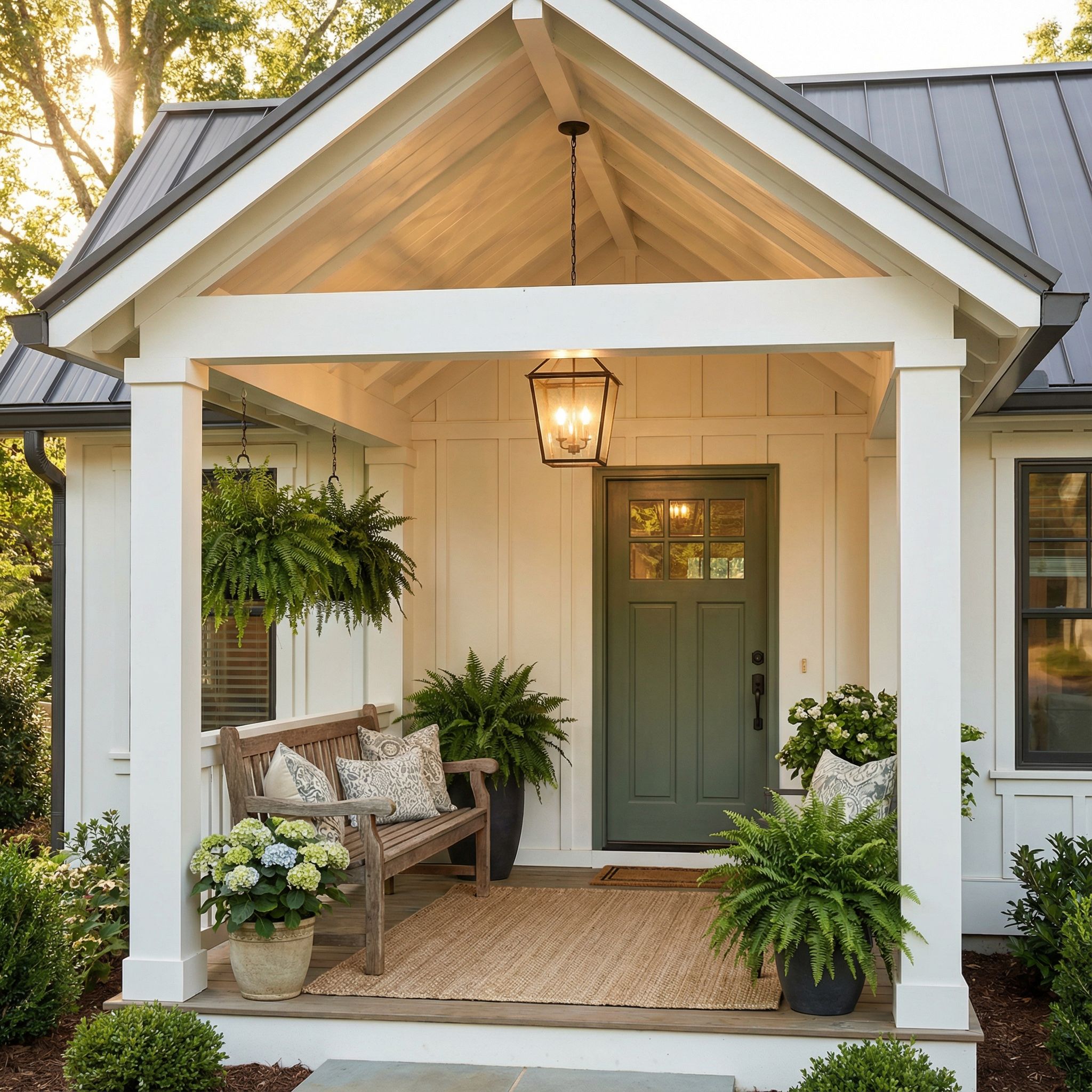
Compact porches prove that “concentrated welcome” requires square footage less than thoughtful design. Even a four-by-eight-foot covered entry provides weather protection and psychological transition when detailed properly. Strategic lighting, a weather-resistant bench, and potted plants create seasonal flexibility, while a well-designed overhang keeps the entrance dry and inviting regardless of precipitation.
Stone Pillar Covered Front Porch Design

Stone pillars embody “geological permanence,” connecting homes to landscape through material continuity. These substantial supports withstand decades of freeze-thaw cycles without deterioration while requiring zero seasonal maintenance. Psychologically, stone creates feelings of security and timelessness. The thermal mass also moderates temperature swings, keeping porches slightly warmer in winter and cooler in summer naturally.
Coastal Covered Front Porch with Nautical Elements
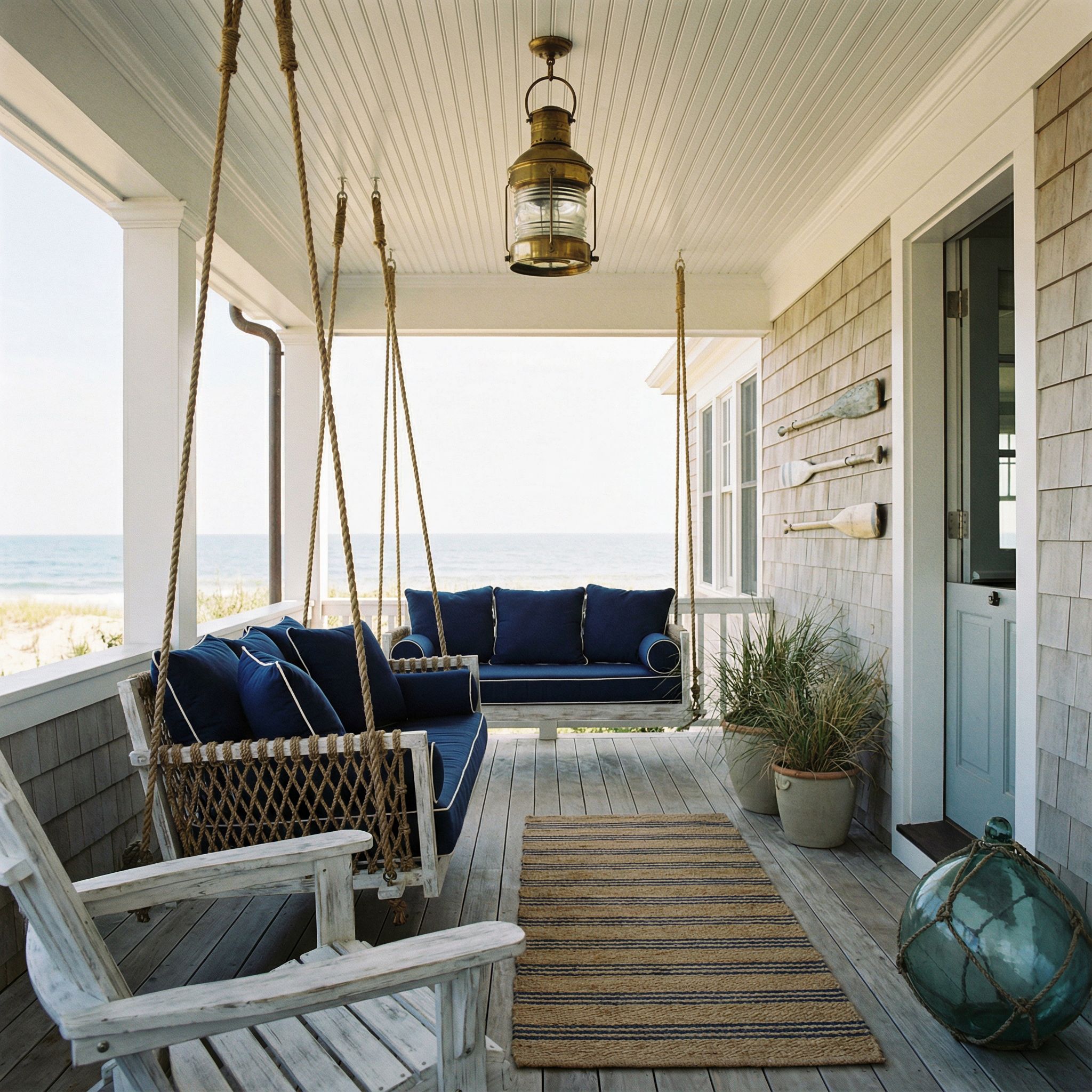
Coastal porches employ “weatherproof whimsy” through materials and details that withstand salt air and high winds. Composite decking, stainless steel hardware, and painted finishes in blues and whites resist corrosion while maintaining seaside character. Elevated designs allow storm surge protection, while open railings permit wind passage. These porches celebrate rather than fight their environment seasonally.
Rustic Covered Front Porch with Wood Beams
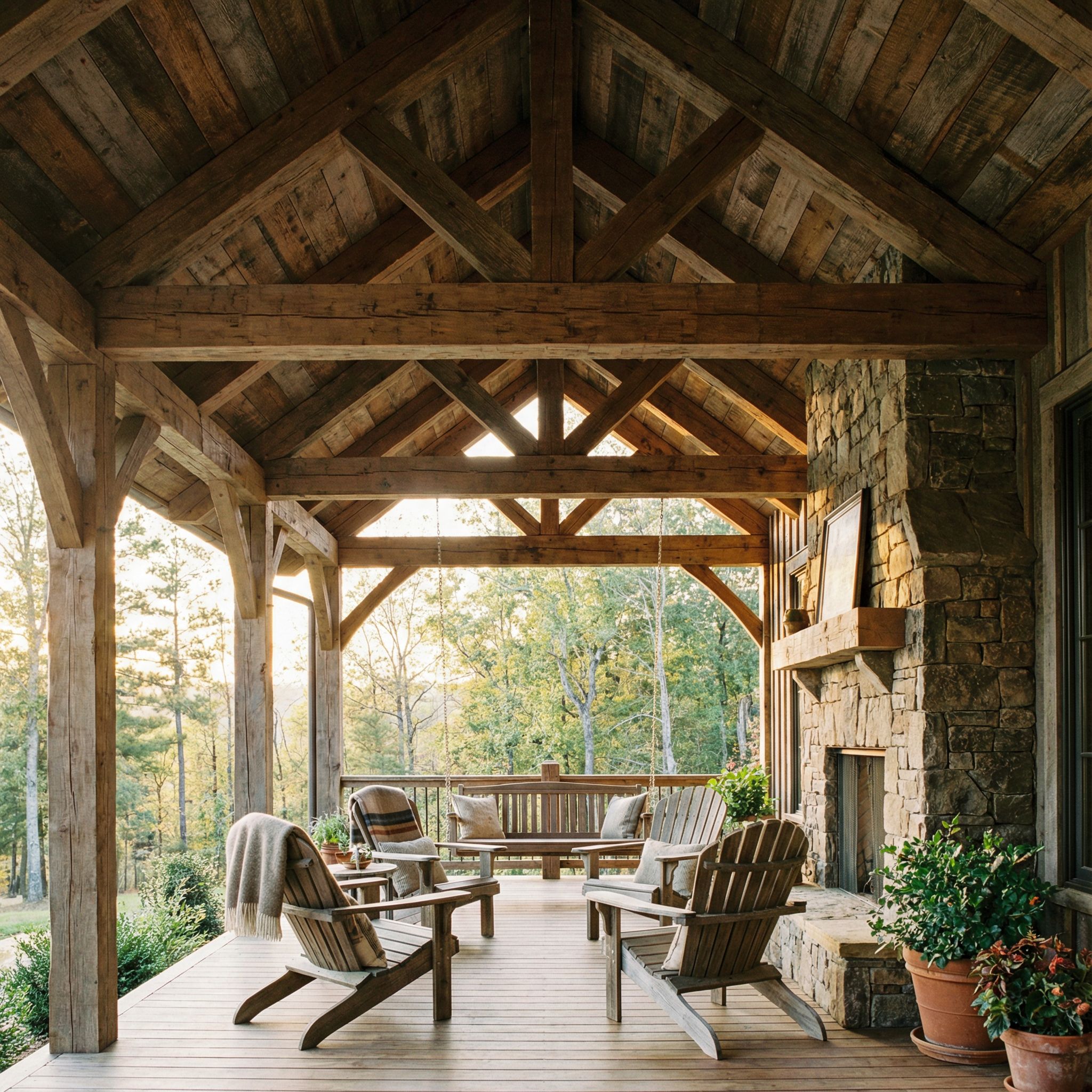
Exposed wood beams create “textural warmth,” adding dimension and character while supporting roof structures. Reclaimed timbers or rough-sawn lumber develops beautiful patina across seasons, improving aesthetically with age. The natural material connects inhabitants to organic cycles—wood darkens, weathers, and settles—creating living architecture that celebrates rather than resists seasonal change and environmental exposure.
Contemporary Covered Front Porch with Metal Accents

Metal elements introduce “industrial refinement” through steel posts, aluminum trim, and perforated panels that create pattern and shadow. These materials excel seasonally because they won’t rot, warp, or require painting. Contemporary porches often incorporate cantilevered roofs or asymmetrical designs that provide adequate coverage while making bold architectural statements that remain striking against both summer greenery and winter snow.
Victorian Covered Front Porch with Decorative Trim

Victorian gingerbread trim represents “ornamental joy,” transforming functional porches into decorative showcases. While elaborate, quality woodwork actually protects underlying structures by directing water away through layered details. Seasonally, the intricate shadows cast by brackets and spindles create ever-changing patterns. Modern materials like PVC trim maintain Victorian aesthetics without the intensive maintenance traditional wood demanded.
Deep Covered Front Porch for Year-Round Use
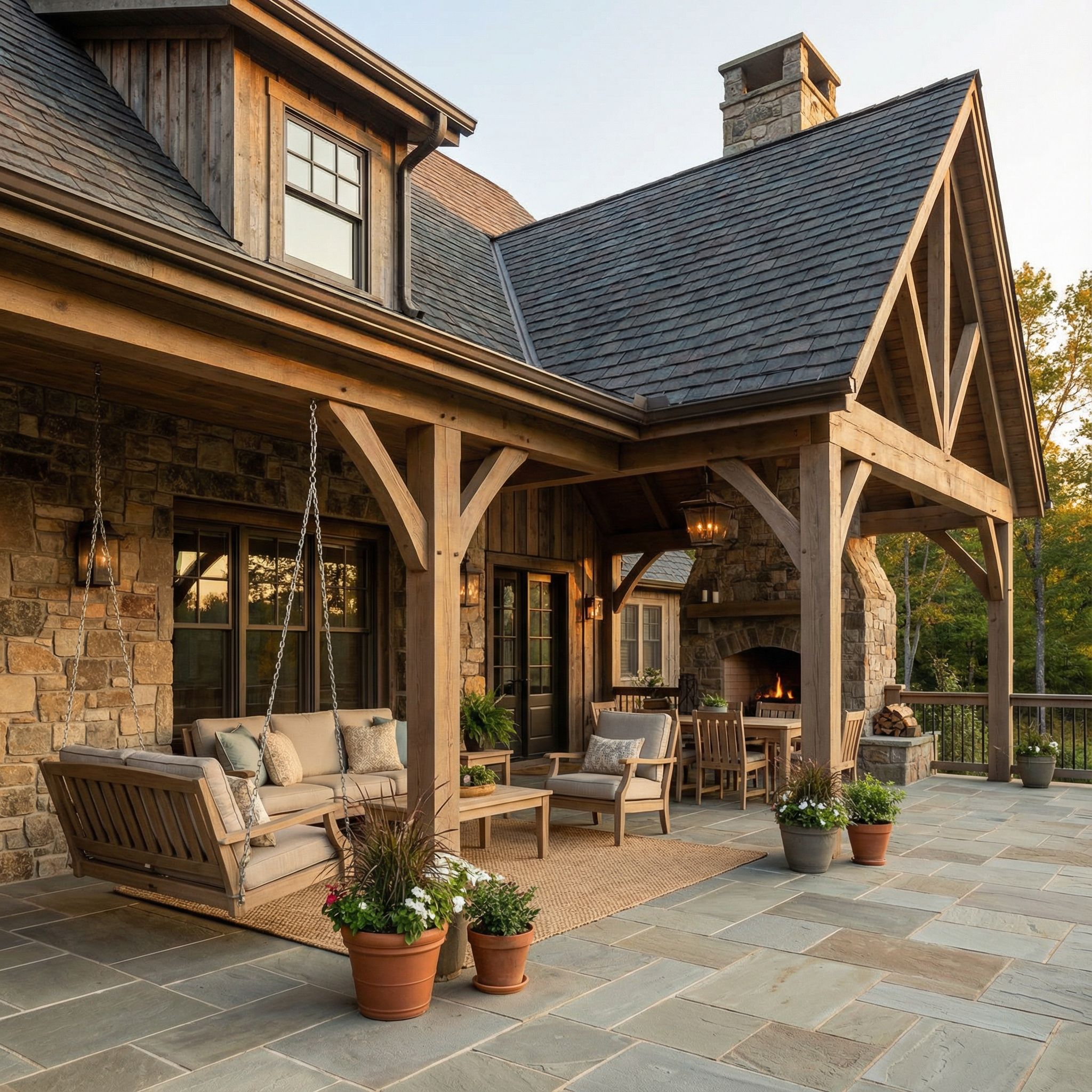
Depth determines functionality—porches extending ten or more feet create “outdoor rooms” genuinely usable across seasons. Substantial coverage protects furniture from precipitation and UV damage, while deep shade moderates summer heat. In winter, southern-facing deep porches capture low-angle sunlight, creating surprisingly comfortable spaces. This depth psychologically shifts porches from thresholds to destinations encouraging extended seasonal use.
Brick Column Covered Front Porch Classic
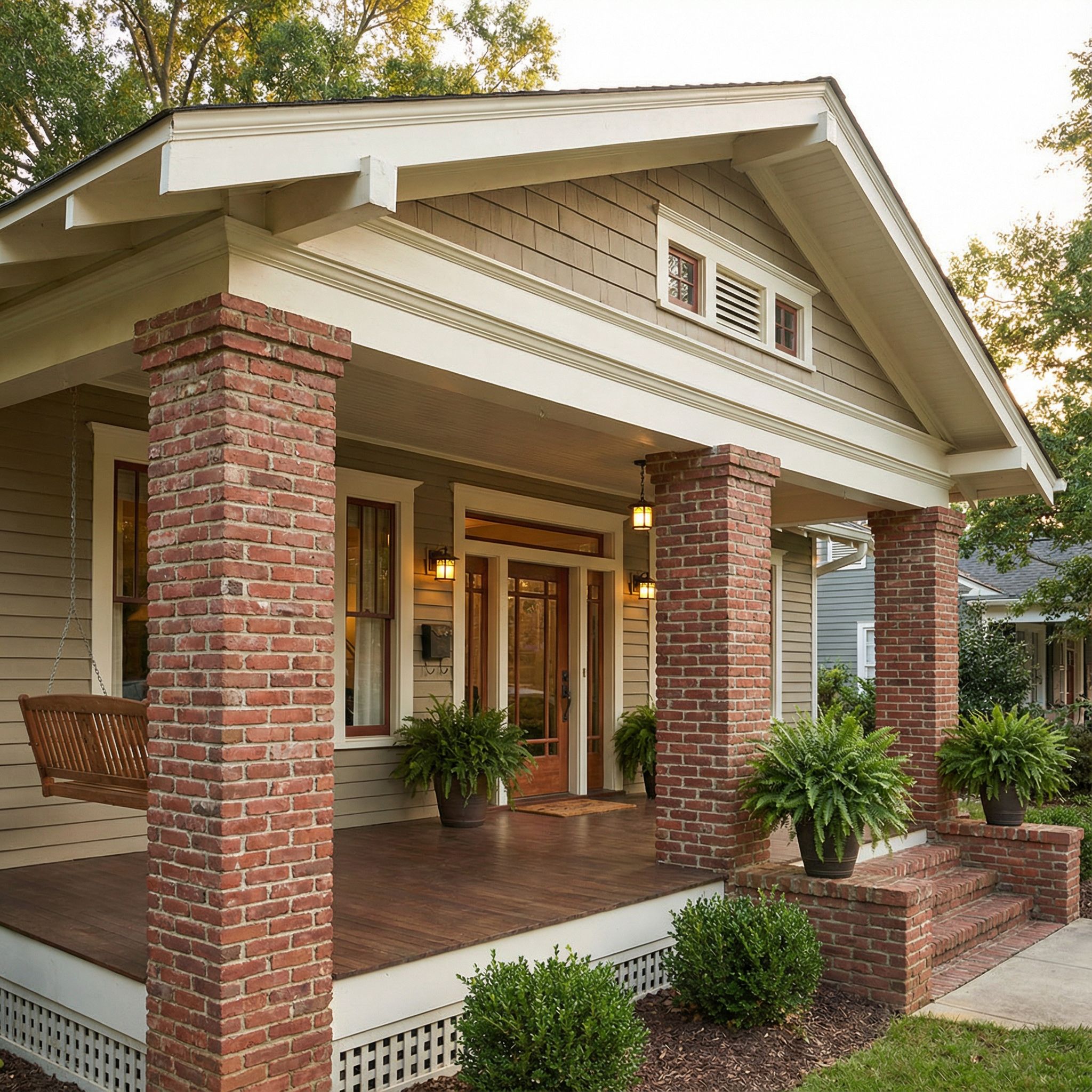
Brick columns offer “maintenance-free tradition,” combining classic aesthetics with virtually zero upkeep. The material withstands temperature extremes, moisture, and impacts while aging gracefully. Brick’s thermal properties moderate porch temperatures naturally, and its textured surface adds visual interest without requiring paint or stain. This permanence creates psychological comfort—your porch looks identical whether sunny July or snowy January.
Shallow Covered Front Porch for Narrow Lots

Shallow porches practice “strategic minimalism,” providing essential weather protection on space-constrained properties. Even a three-foot overhang keeps entries dry and creates psychological separation from the street. Vertical elements like tall planters, wall-mounted lighting, and climbing vines add dimension without consuming floor space. Smart material choices ensure these compact spaces remain attractive and functional year-round.
Gable Roof Covered Front Porch Design
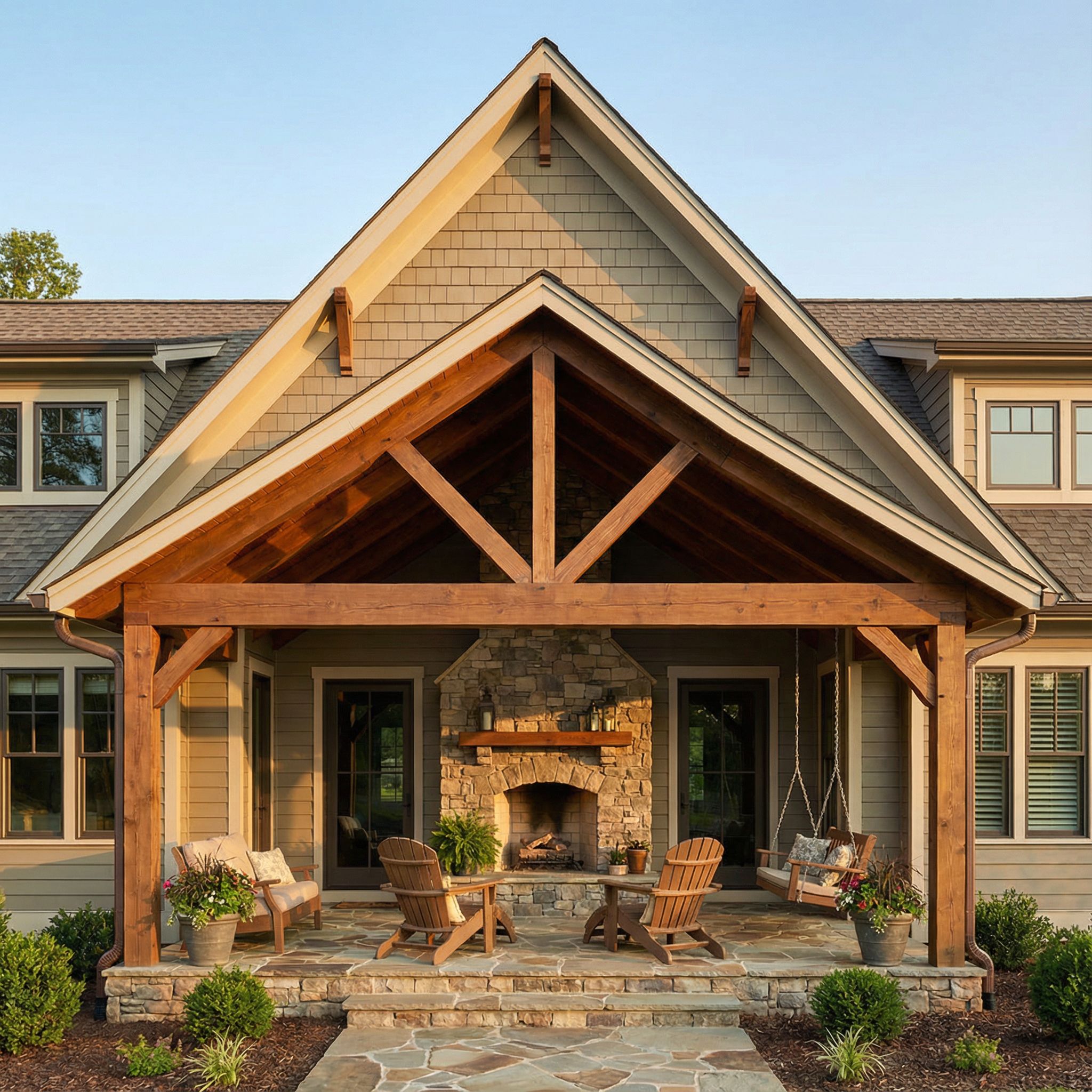
Gable roofs create “architectural focal points” that draw eyes upward while efficiently shedding rain and snow. The peaked design prevents accumulation, crucial for year-round functionality in variable climates. Psychologically, gables suggest shelter and home—archetypal roof shapes that feel instinctively welcoming. Enhanced attic ventilation in gable designs also prevents ice dams and moisture buildup during winter months.
Flat Roof Covered Front Porch Contemporary Style

Flat roofs embody “horizontal modernism,” creating clean lines that complement contemporary architecture. Despite appearing flat, properly designed versions incorporate slight slopes for drainage, ensuring year-round weather protection. The simplified geometry suits minimalist aesthetics while potentially providing rooftop deck space above. Modern waterproofing membranes make flat roofs as durable as pitched alternatives across all seasonal conditions.
Corner Covered Front Porch with Dual Entries
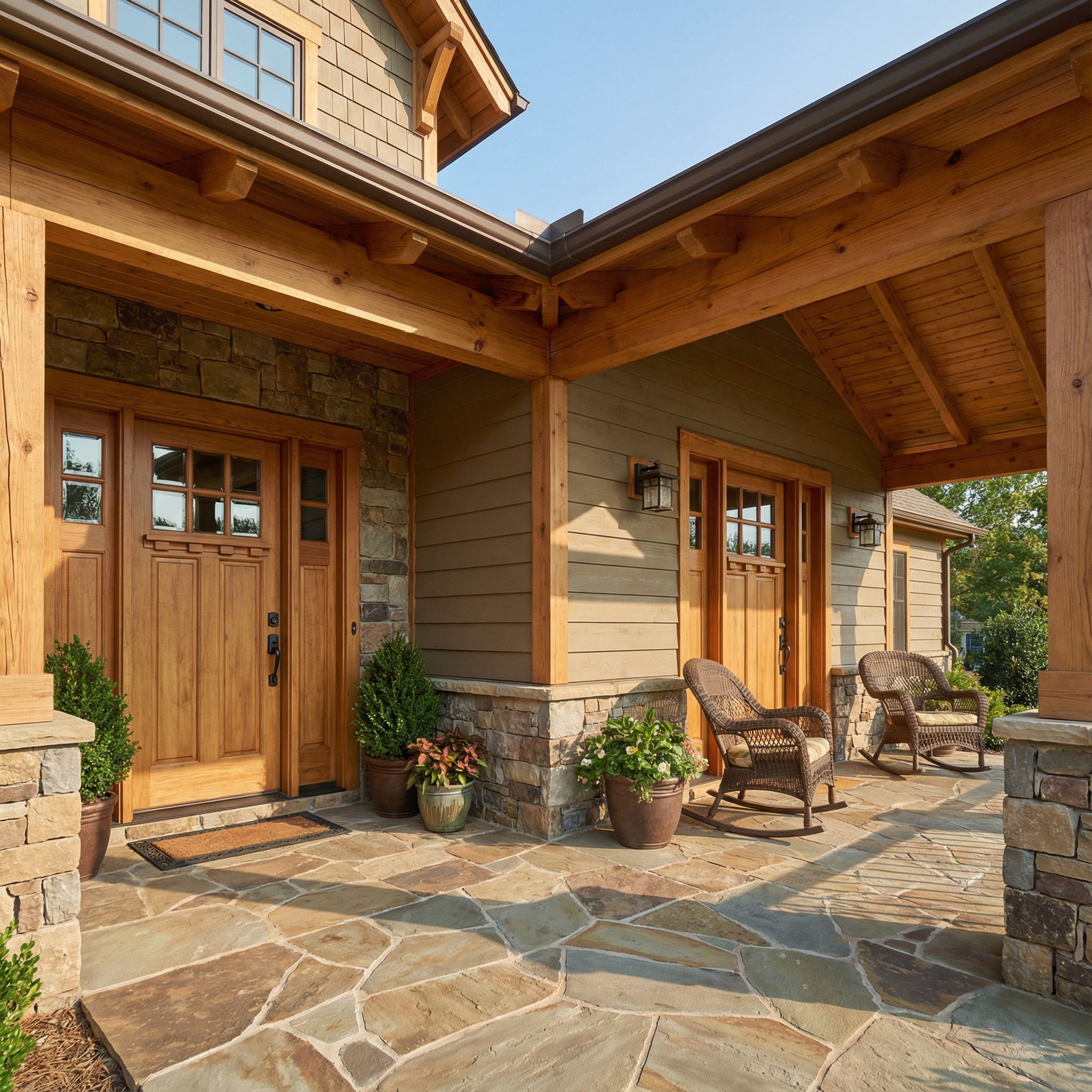
Corner porches offer “directional hospitality,” welcoming guests from multiple approaches while maximizing covered area on L-shaped homes. This configuration creates interesting spatial dynamics and abundant seating options. Seasonally, the dual orientation provides sun-tracking flexibility—morning coffee on one side, afternoon shade on another. The generous coverage protects multiple doors, reducing weather infiltration significantly.
Heated Covered Front Porch for Winter Enjoyment

Radiant heaters or heated flooring transform porches into “winter sanctuaries,” extending usability into cold months traditionally considered off-season. Infrared heaters warm people without heating air, remaining efficient even in breezy conditions. This investment changes the psychological relationship with winter—rather than retreating indoors, inhabitants can enjoy snowfall from comfortable warmth, experiencing seasons more fully.
Covered Front Porch with Outdoor Ceiling Fans
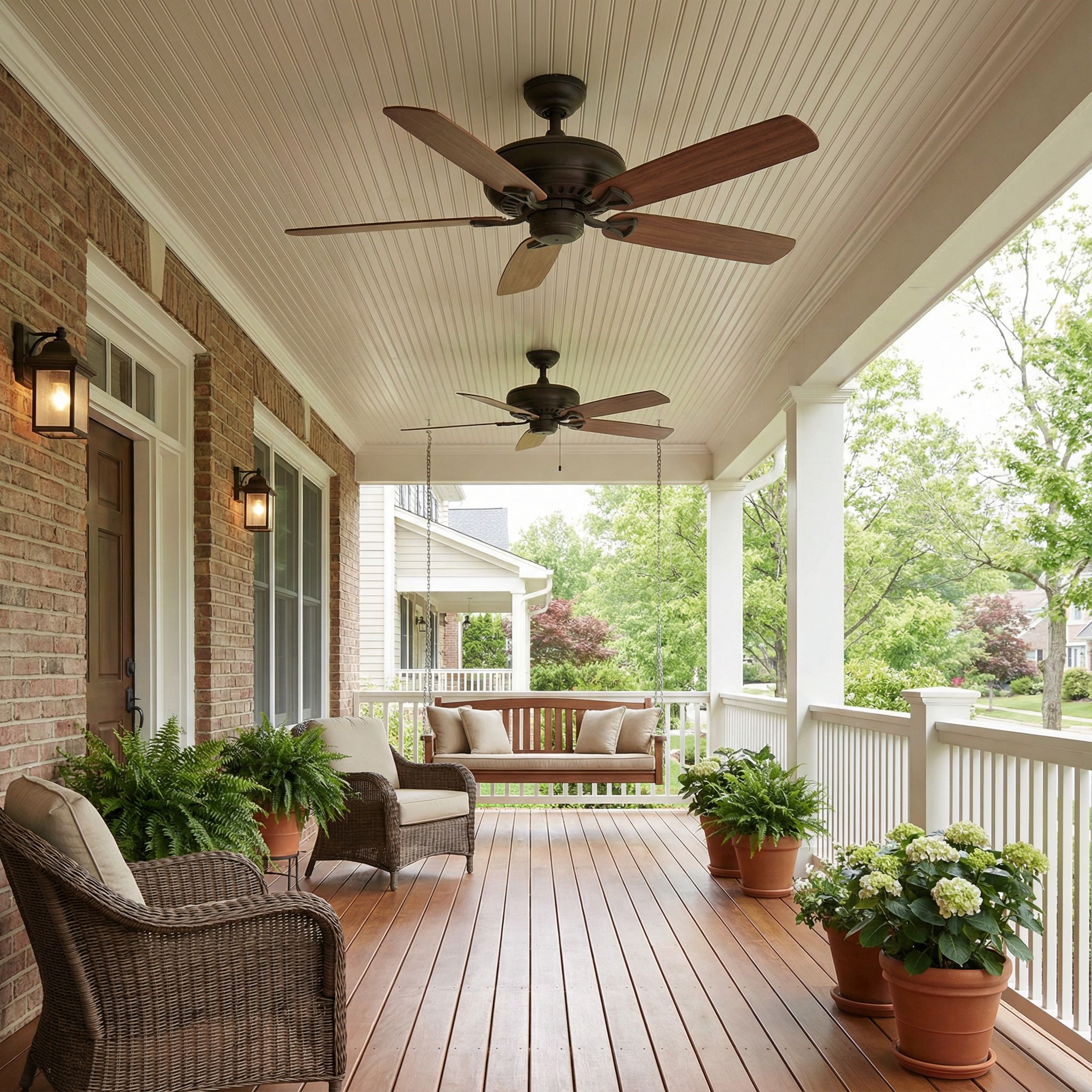
Ceiling fans provide “active climate control,” circulating air during humid summers while pushing warm air downward during cooler months when heating elements are used. The gentle breeze makes porches comfortable at higher temperatures, reducing cooling costs. Psychologically, moving air feels refreshing and keeps insects at bay. Weather-rated fans withstand moisture and temperature fluctuations reliably.
Glass-Enclosed Covered Front Porch for All Weather
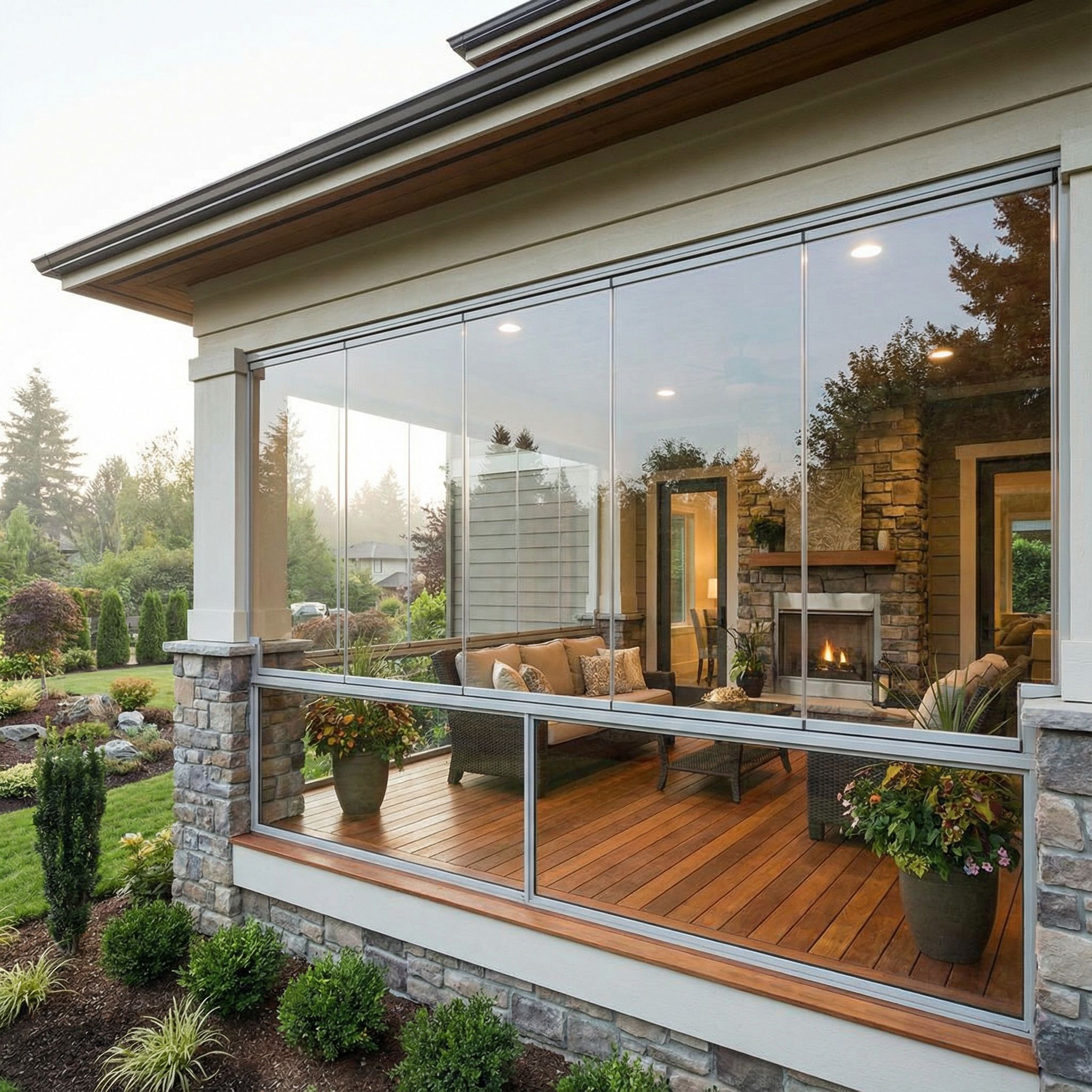
Glass enclosures create “transparent protection,” maintaining views and natural light while blocking wind, rain, and temperature extremes. Retractable or removable panels allow seasonal adjustment—fully enclosed in winter, completely open in summer. This flexibility makes porches genuinely four-season spaces. The psychological benefit is profound—connecting with outdoors without discomfort, observing weather changes from complete shelter.
Covered Front Porch with Built-In Seating

Built-in benches demonstrate “permanent hospitality,” ensuring seating is always available regardless of furniture storage. Integrated designs withstand weather better than movable pieces and create clean, cohesive aesthetics. Storage beneath seating accommodates seasonal items—cushions, garden tools, winter salt. Psychologically, built-ins suggest the porch is meant for lingering, encouraging greater use across all seasons.
Cedar Shake Covered Front Porch Design
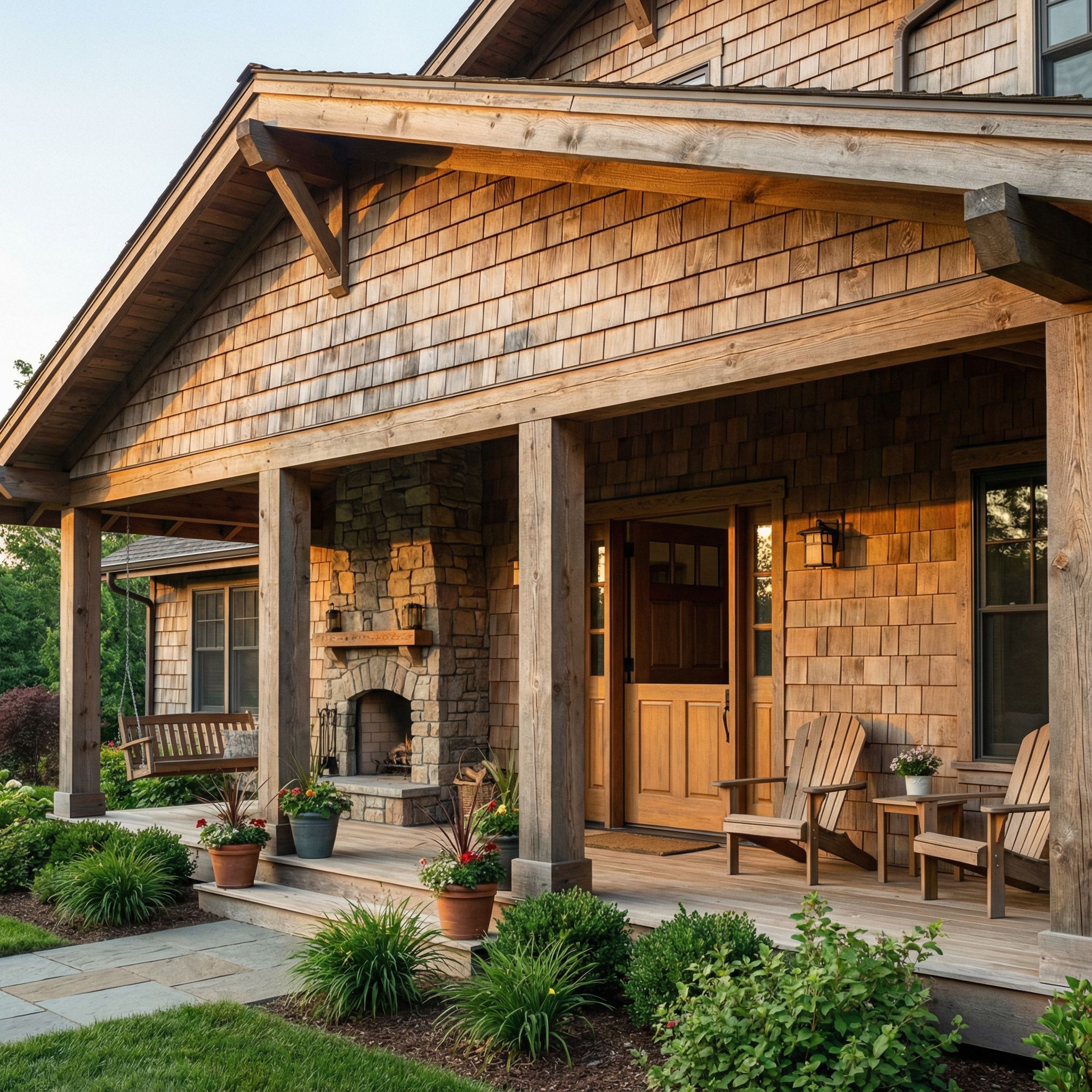
Cedar shakes provide “natural sophistication,” offering superior weather resistance through wood’s inherent oils while developing beautiful silver patina over time. The material insulates better than composite alternatives, moderating porch temperatures seasonally. Cedar’s organic texture adds depth and character, connecting architecture to natural landscapes. Properly installed shakes last decades, requiring minimal maintenance while improving aesthetically with age.
Asymmetrical Covered Front Porch with Character
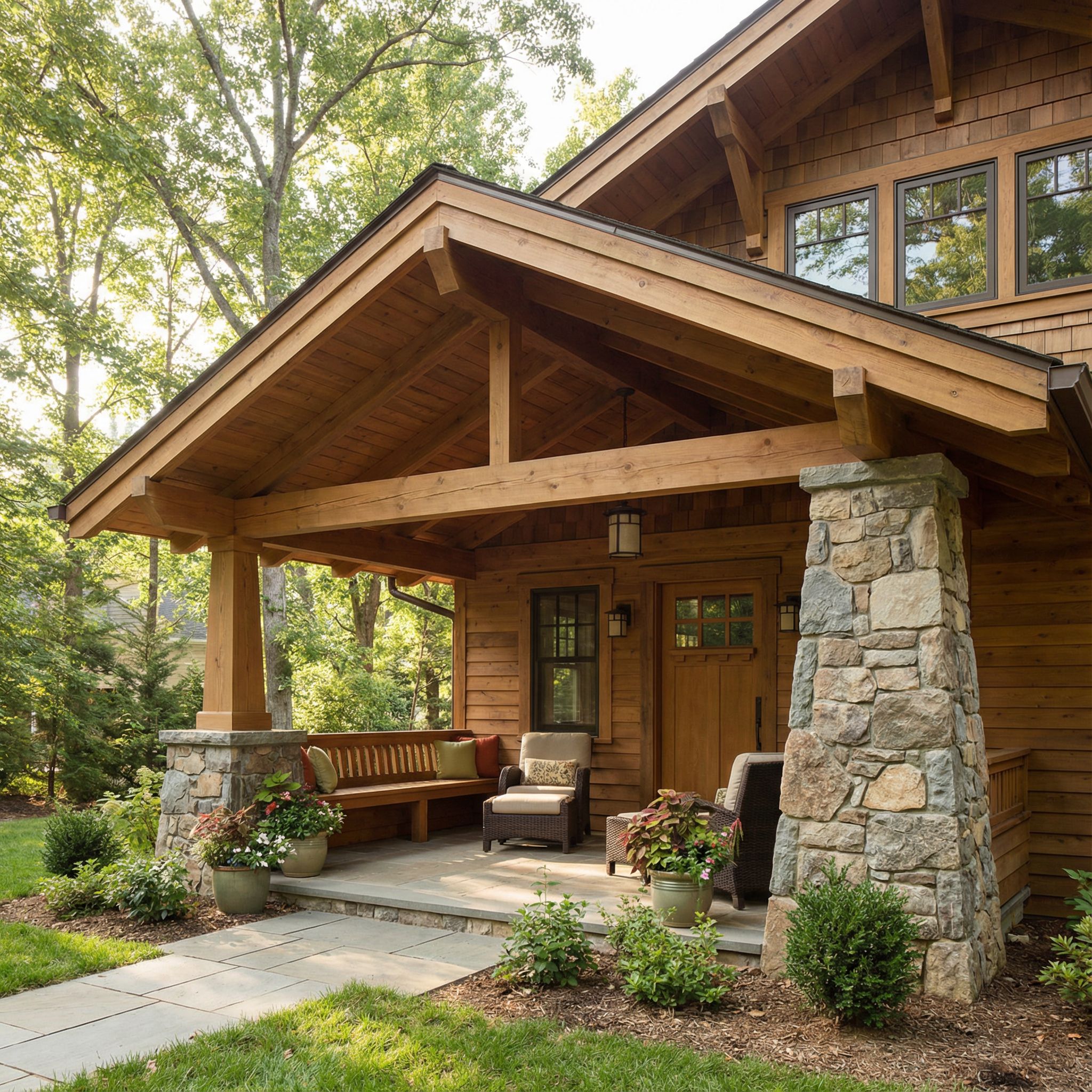
Asymmetry introduces “intentional dynamism,” breaking conventional expectations to create memorable entries. Off-center posts, varied roof heights, or angled approaches add visual interest while potentially improving functionality—larger coverage where needed, open areas for light elsewhere. This unconventional approach works seasonally because good design prioritizes weather protection and usability over mere symmetry.
Covered Front Porch with Outdoor Fireplace Feature
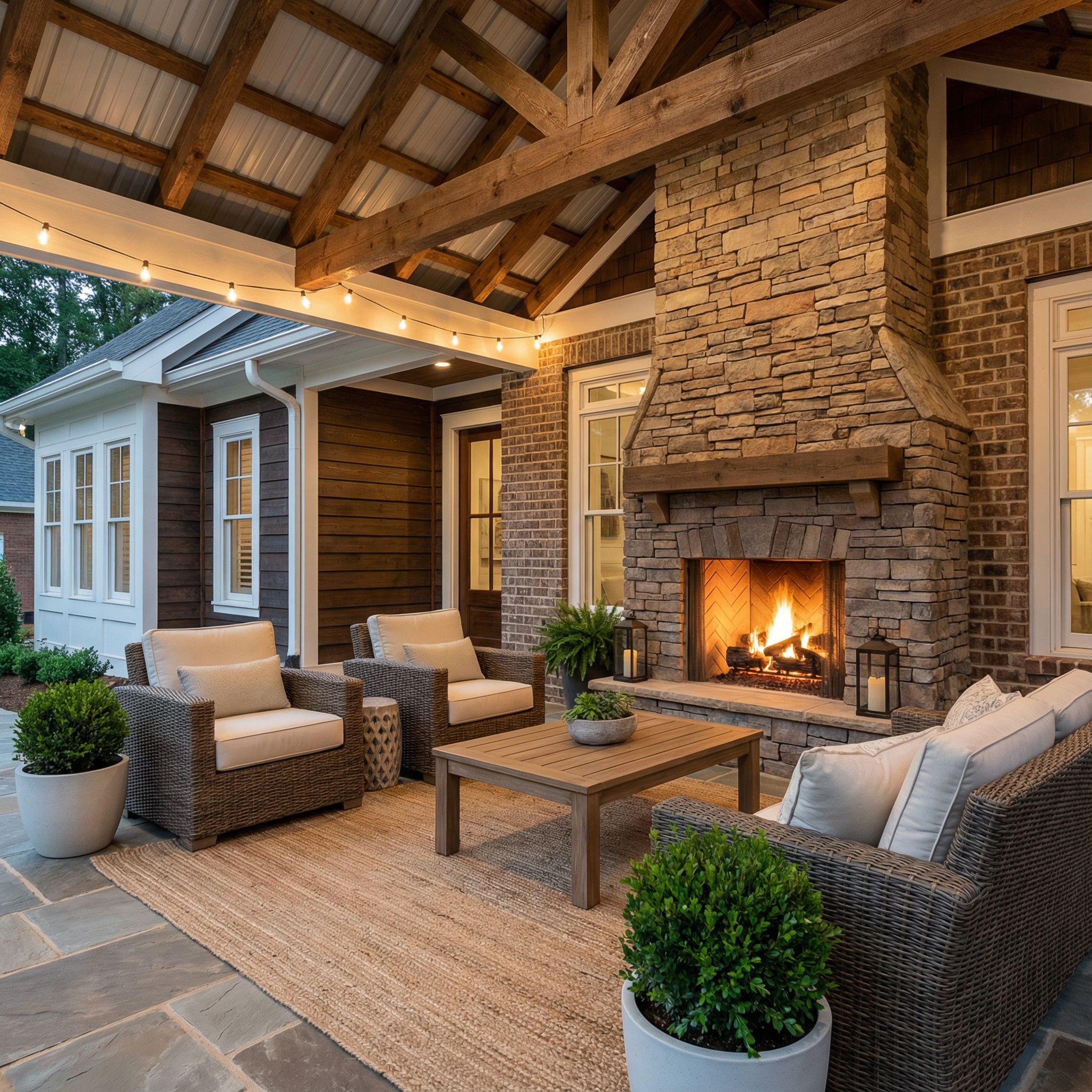
Fireplaces establish “thermal destinations,” creating focal points that dramatically extend cold-weather usability. The radiant heat makes autumn evenings and spring mornings genuinely comfortable, while the psychological draw of fire encourages gathering. Even when unlit, a substantial fireplace anchors porch design, providing architectural interest year-round. Gas options offer convenience; wood-burning creates authentic atmosphere.
Multi-Level Covered Front Porch Design
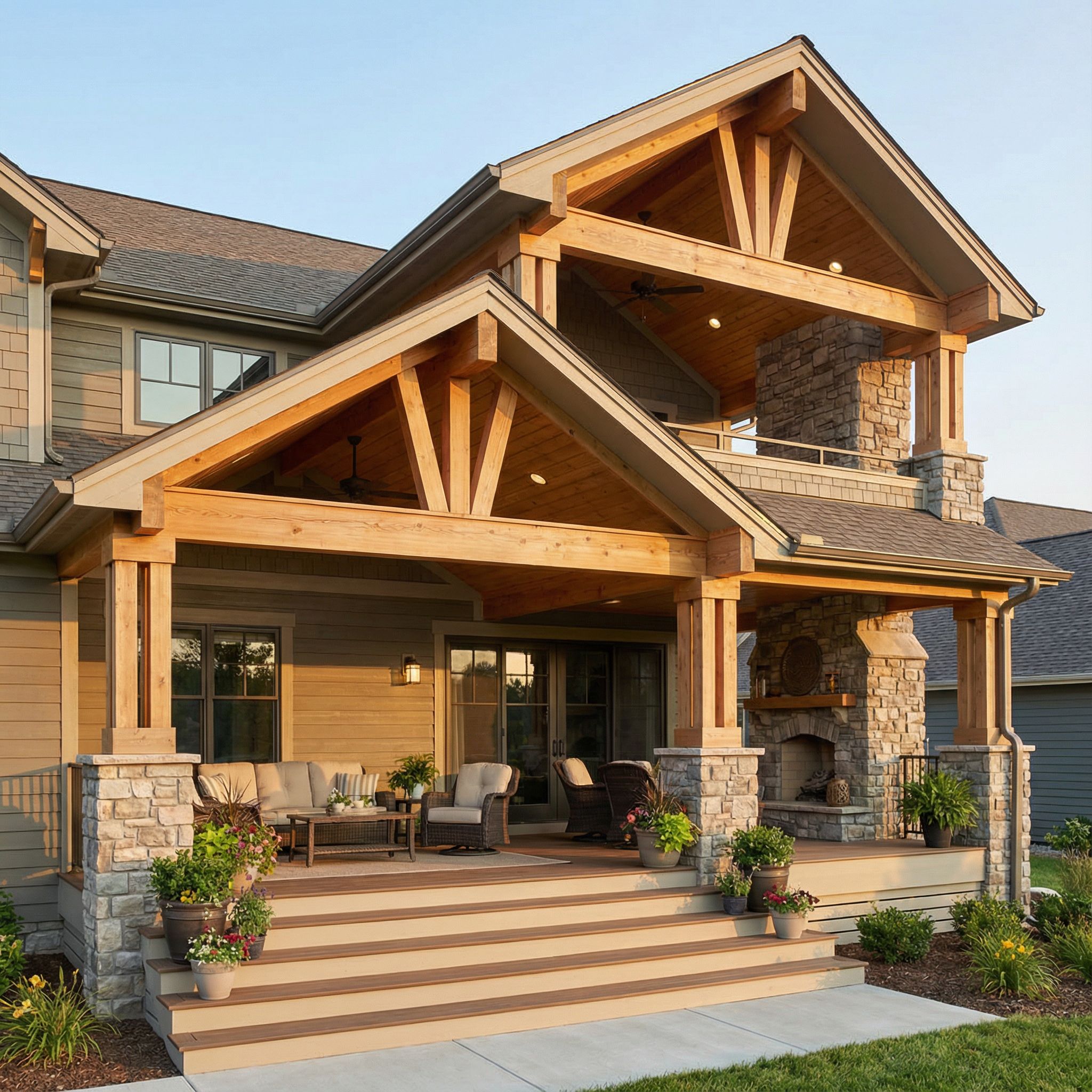
Stepped porches create “graduated transitions,” especially effective on sloped lots where they connect different elevations gracefully. Multiple levels define separate zones—upper dining, lower lounging—without walls. Seasonally, varied heights capture different sun angles and breezes. The dimensional complexity adds architectural interest while the extensive coverage protects larger square footage from weather.
Covered Front Porch with Decorative Railings
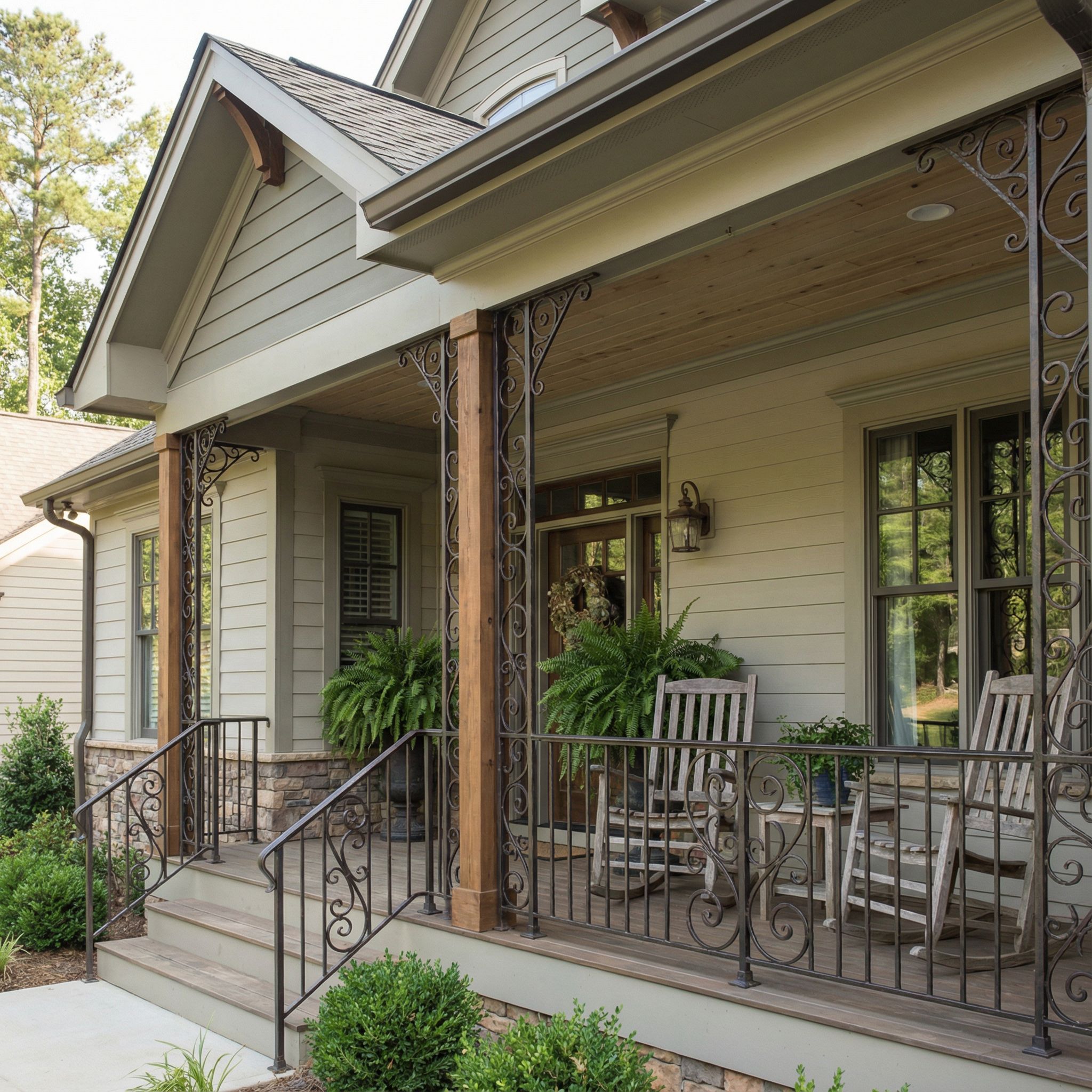
Railings balance “safety and style,” required by code but offering significant design opportunities. Materials range from classic wood balusters to contemporary cable systems, each creating different visual effects and maintenance requirements. Seasonally, open railing designs allow air circulation and snow shedding, while the horizontal or vertical lines frame landscape views beautifully regardless of season.
Ranch-Style Covered Front Porch with Low Profile
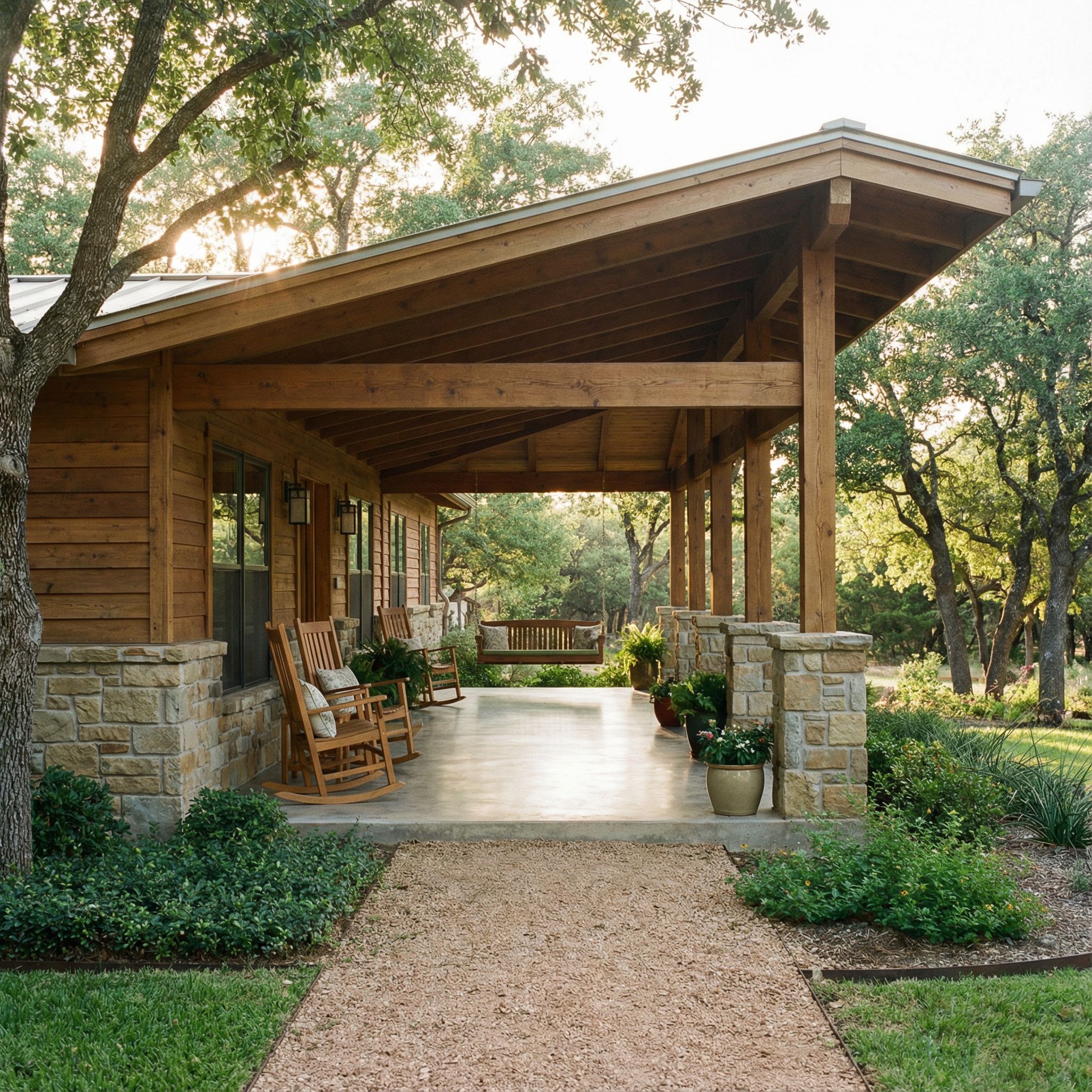
Low-profile porches embrace “horizontal harmony,” complementing ranch architecture’s ground-hugging aesthetic. Shallow roof pitches and wide overhangs create sheltered spaces without overwhelming single-story facades. This modest approach works year-round through simplicity—fewer details mean less maintenance, while the straightforward design sheds weather efficiently. Psychologically, the accessible, non-imposing design feels welcoming and approachable.
Covered Front Porch with String Lighting Design

String lights add “ambient enchantment,” transforming porches from daytime spaces into evening destinations across all seasons. The soft, scattered illumination creates intimate atmosphere while providing functional visibility. Weather-resistant LED strands withstand year-round exposure, glowing warmly against summer twilight or winter snow. This simple addition dramatically increases porch usage during darker months psychologically and practically.
Colonial Covered Front Porch with Symmetry
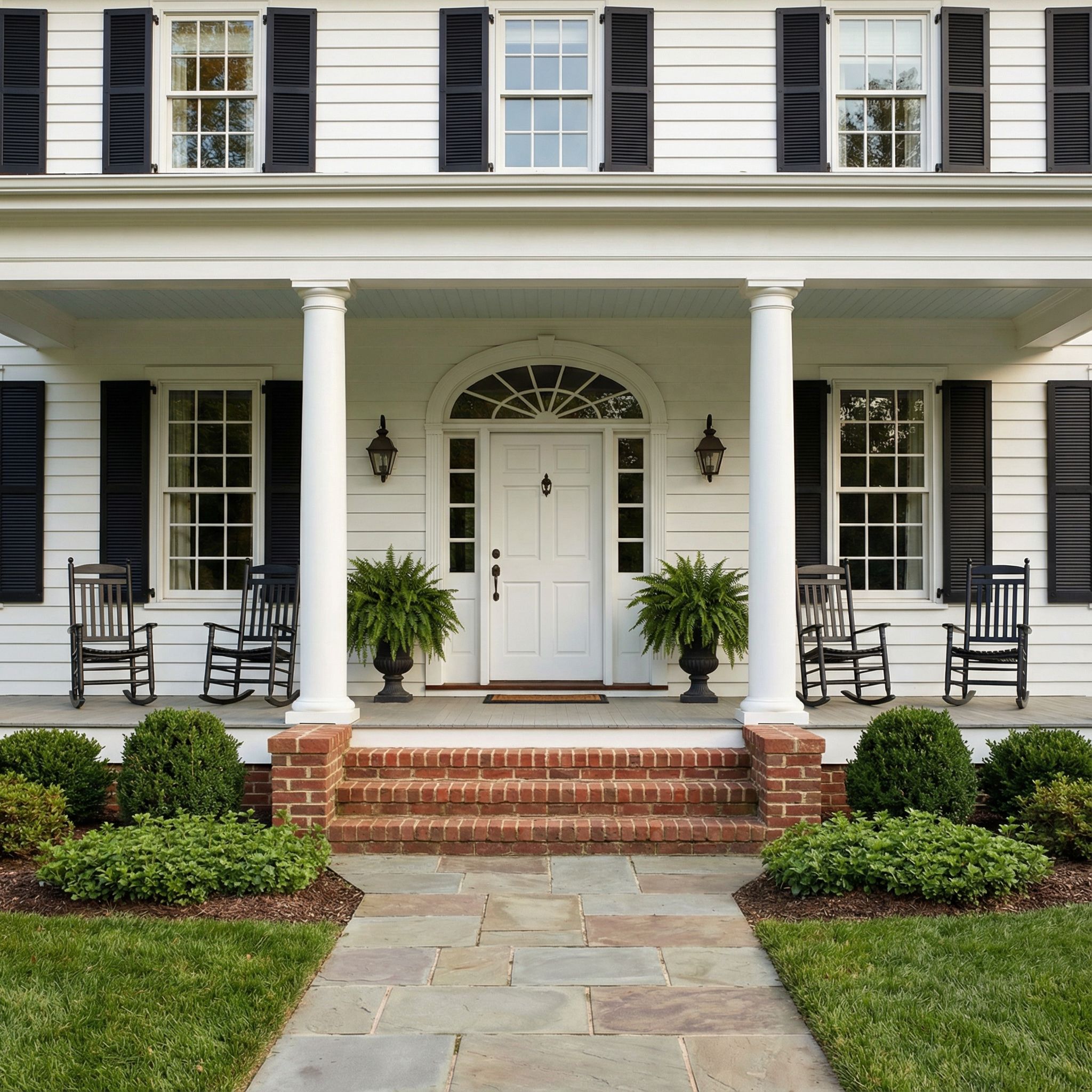
Colonial symmetry represents “balanced formality,” with centered doors flanked by equal windows and evenly spaced columns creating orderly, dignified entries. This classical approach has endured centuries because it works—predictable geometry is inherently stable structurally and psychologically. Seasonally, the balanced design ensures even weather protection and consistent aesthetics regardless of how sunlight, shadows, or seasonal decorations change.
Covered Front Porch with Outdoor Kitchen Setup
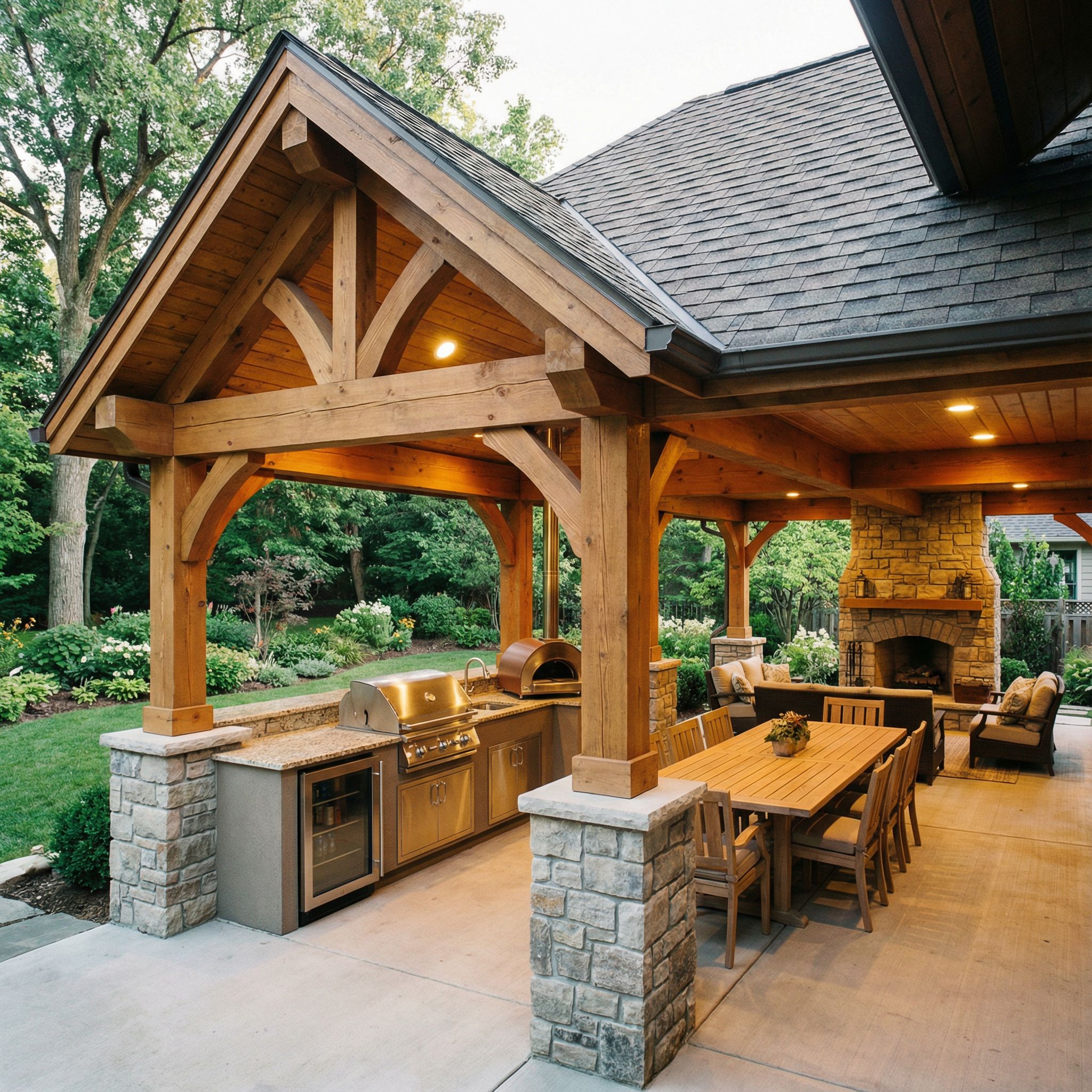
Outdoor kitchens create “culinary extensions,” moving cooking outside during pleasant weather while remaining protected from sudden rain. Built-in grills, refrigerators, and counters transform porches into entertainment zones. Weather-resistant cabinetry and appliances withstand seasonal temperature and humidity fluctuations. This investment increases home value while encouraging year-round outdoor living, making porches destinations rather than mere passageways.
Cottage-Style Covered Front Porch with Charm
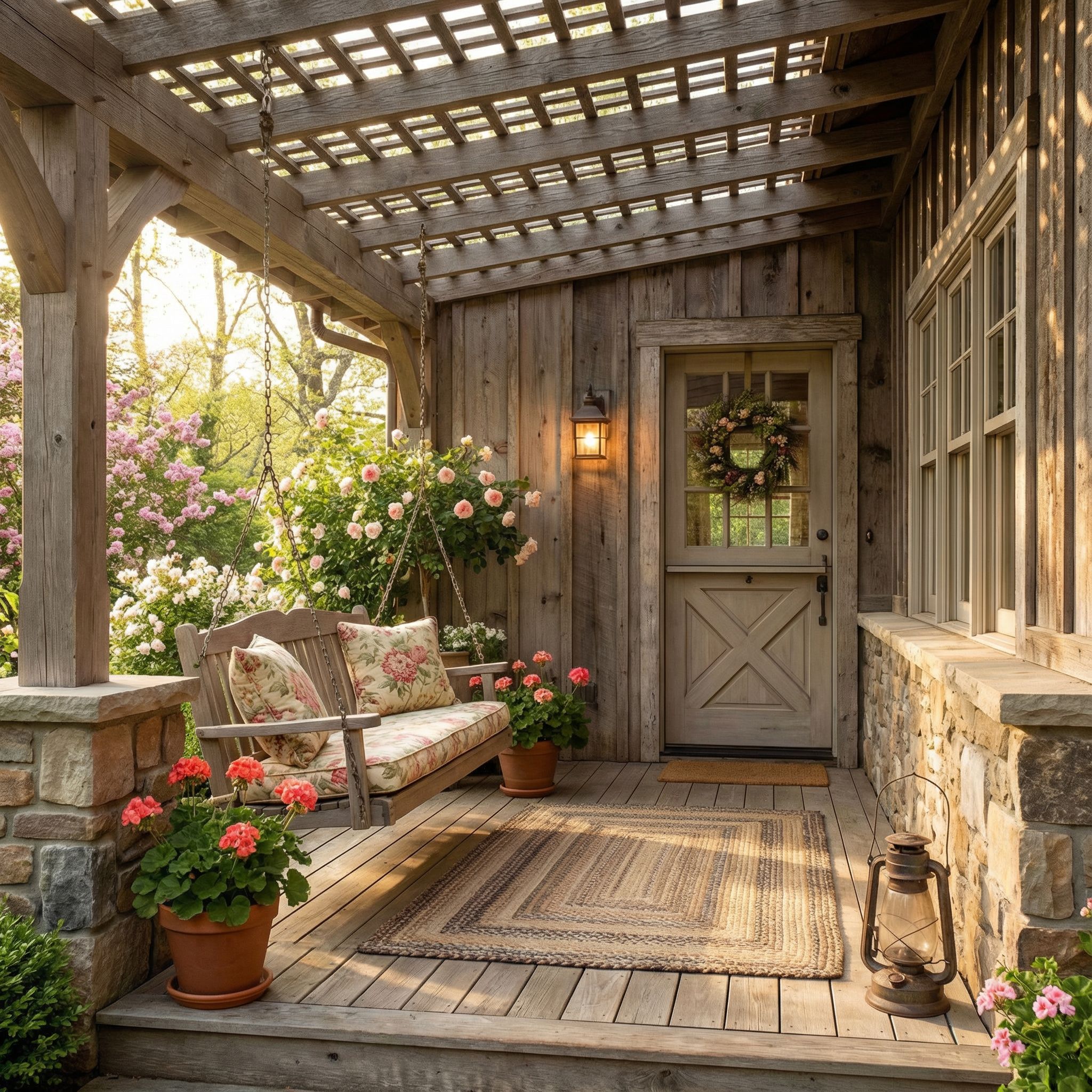
Cottage porches embody “storybook welcome,” featuring cozy proportions, painted finishes, and abundant plantings that create enchanting entries. Smaller columns, decorative brackets, and board-and-batten details add character without pretension. Seasonally, the intimate scale creates protected microclimates—surprisingly warm in winter sun, comfortably shaded in summer. The unpretentious charm encourages relaxation and neighborly interaction year-round.
Covered Front Porch with Privacy Screens
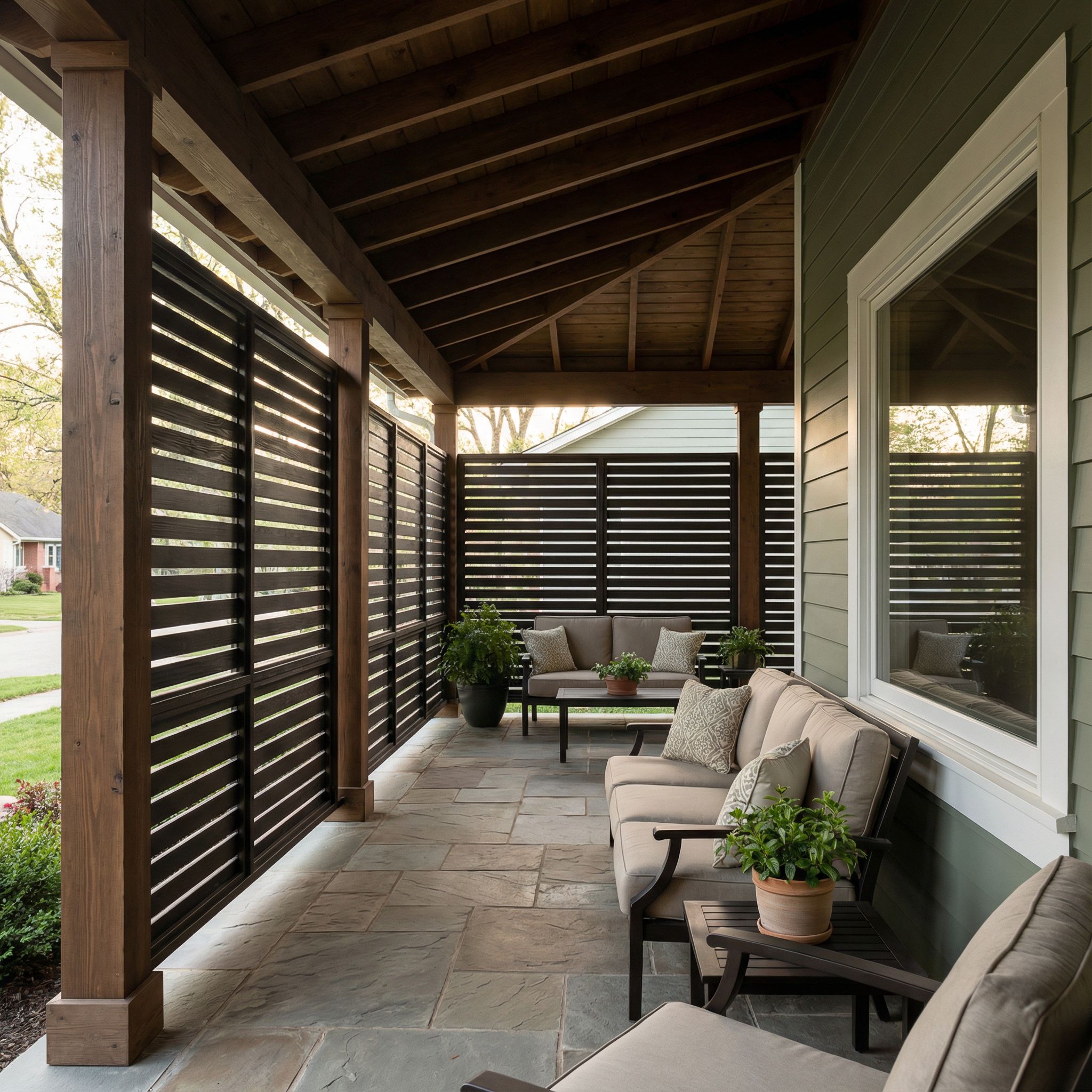
Privacy screens offer “selective transparency,” maintaining airflow and partial views while blocking sightlines from streets or neighboring properties. Lattice, louvered panels, or planted trellises create comfortable enclosure without complete isolation. Seasonally, screens provide wind breaks and shade control. Psychologically, this semi-private zone feels safer and more relaxing, encouraging greater use because inhabitants feel comfortably sheltered.
Industrial Covered Front Porch with Exposed Elements
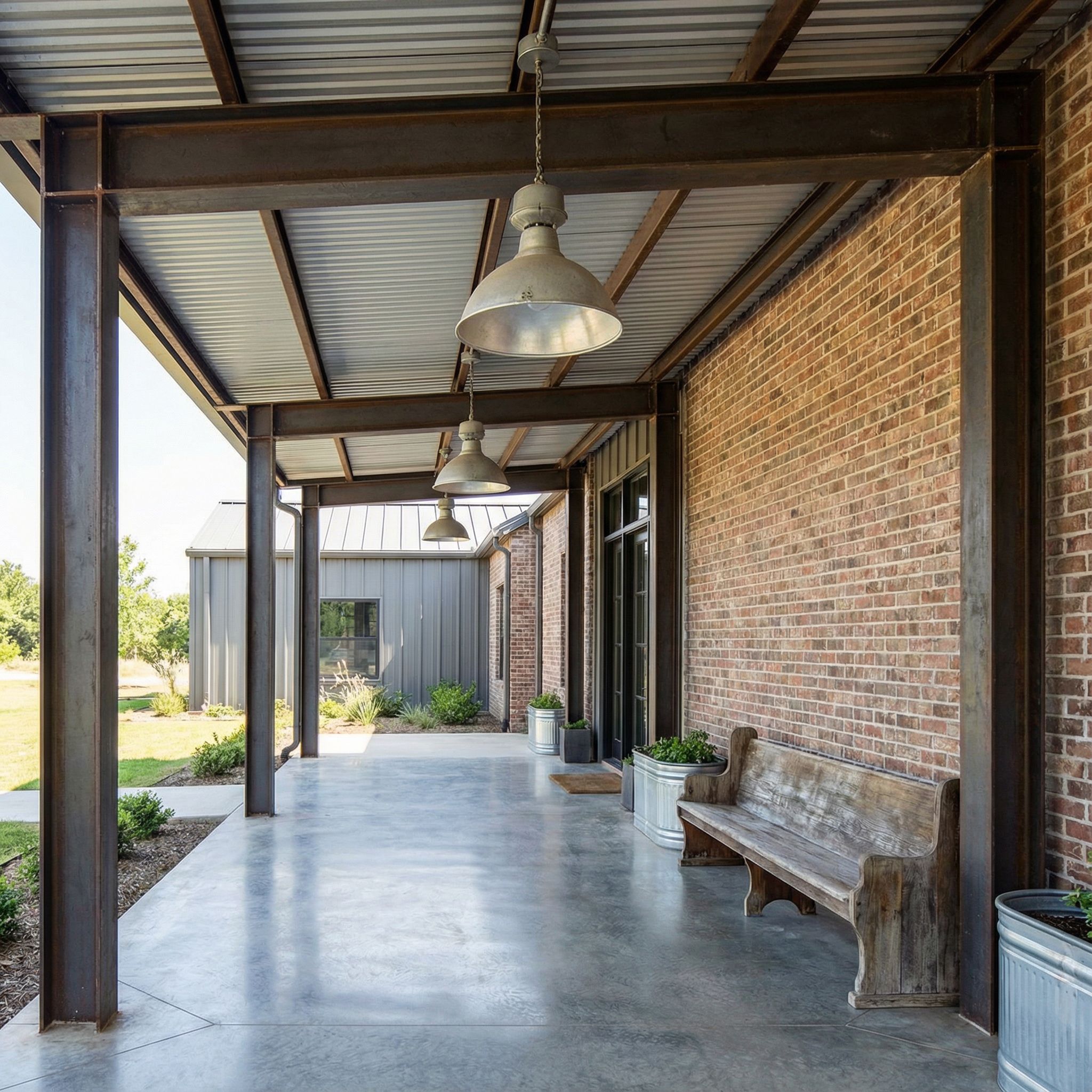
Industrial design celebrates “honest materiality,” showcasing structural elements like steel beams, concrete floors, and metal roofing typically concealed. This aesthetic requires virtually zero maintenance—materials chosen for durability rather than refinement. Seasonally, industrial porches excel because nothing deteriorates—metal doesn’t rot, concrete doesn’t warp. The raw, urban aesthetic creates striking contrast against natural seasonal changes.
Covered Front Porch with Retractable Weather Protection
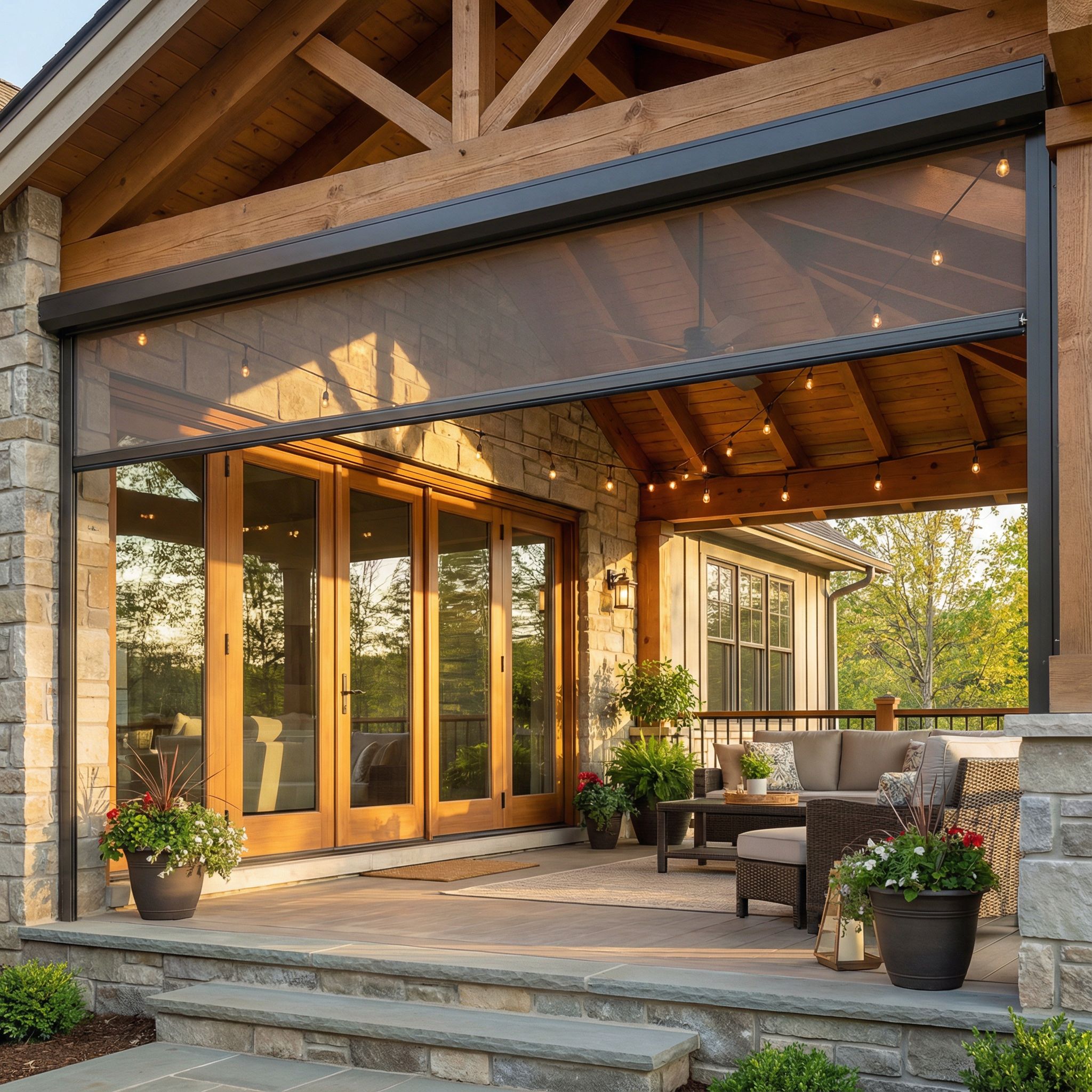
Retractable systems provide “adaptive architecture,” allowing customization based on immediate conditions. Motorized screens drop during rain or high sun, retract for breezes and views. Clear vinyl panels enclose spaces in winter, roll away in summer. This flexibility maximizes year-round comfort and usability. Psychologically, control over the environment increases satisfaction—inhabitants actively shape their space rather than passively accepting conditions.






